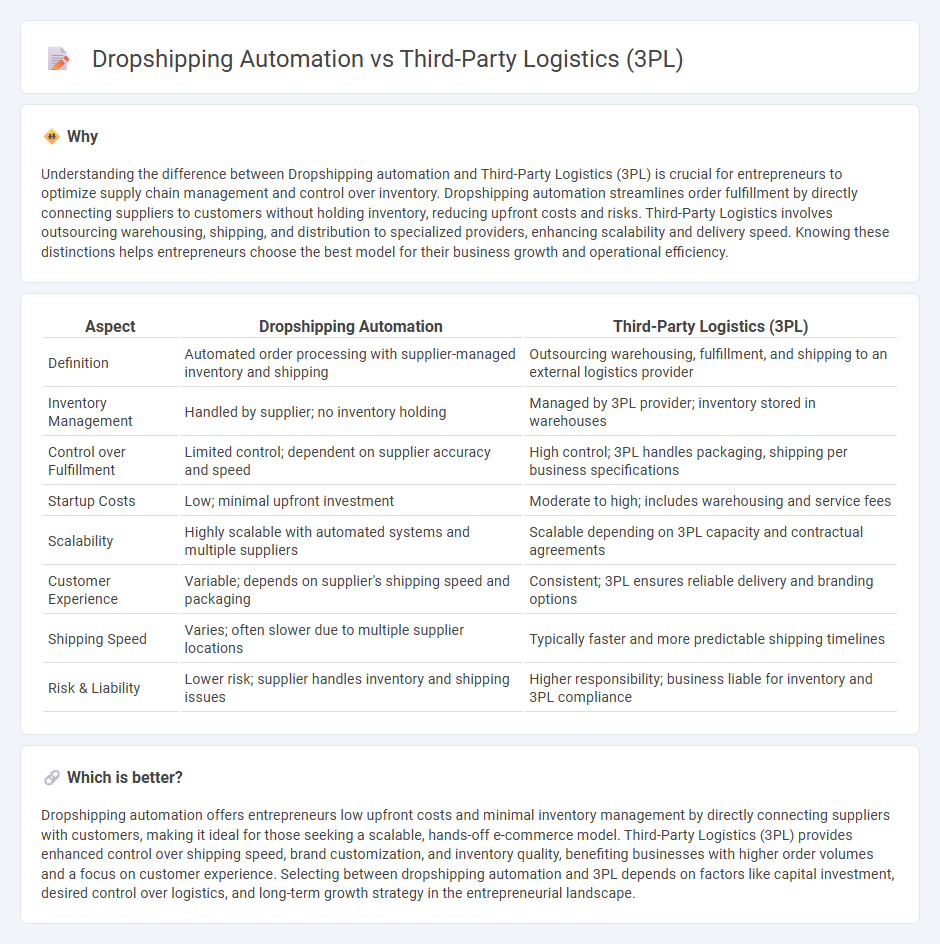
Dropshipping automation streamlines order fulfillment by directly connecting suppliers with customers, minimizing inventory management and upfront costs. Third-Party Logistics (3PL) offers comprehensive supply chain solutions, including warehousing, packaging, and shipping, providing scalability for growing businesses. Explore the advantages and challenges of each approach to determine the best fit for your entrepreneurial strategy.
Why it is important
Understanding the difference between Dropshipping automation and Third-Party Logistics (3PL) is crucial for entrepreneurs to optimize supply chain management and control over inventory. Dropshipping automation streamlines order fulfillment by directly connecting suppliers to customers without holding inventory, reducing upfront costs and risks. Third-Party Logistics involves outsourcing warehousing, shipping, and distribution to specialized providers, enhancing scalability and delivery speed. Knowing these distinctions helps entrepreneurs choose the best model for their business growth and operational efficiency.
Comparison Table
| Aspect | Dropshipping Automation | Third-Party Logistics (3PL) |
|---|---|---|
| Definition | Automated order processing with supplier-managed inventory and shipping | Outsourcing warehousing, fulfillment, and shipping to an external logistics provider |
| Inventory Management | Handled by supplier; no inventory holding | Managed by 3PL provider; inventory stored in warehouses |
| Control over Fulfillment | Limited control; dependent on supplier accuracy and speed | High control; 3PL handles packaging, shipping per business specifications |
| Startup Costs | Low; minimal upfront investment | Moderate to high; includes warehousing and service fees |
| Scalability | Highly scalable with automated systems and multiple suppliers | Scalable depending on 3PL capacity and contractual agreements |
| Customer Experience | Variable; depends on supplier's shipping speed and packaging | Consistent; 3PL ensures reliable delivery and branding options |
| Shipping Speed | Varies; often slower due to multiple supplier locations | Typically faster and more predictable shipping timelines |
| Risk & Liability | Lower risk; supplier handles inventory and shipping issues | Higher responsibility; business liable for inventory and 3PL compliance |
Which is better?
Dropshipping automation offers entrepreneurs low upfront costs and minimal inventory management by directly connecting suppliers with customers, making it ideal for those seeking a scalable, hands-off e-commerce model. Third-Party Logistics (3PL) provides enhanced control over shipping speed, brand customization, and inventory quality, benefiting businesses with higher order volumes and a focus on customer experience. Selecting between dropshipping automation and 3PL depends on factors like capital investment, desired control over logistics, and long-term growth strategy in the entrepreneurial landscape.
Connection
Dropshipping automation streamlines order processing and inventory management by integrating with Third-Party Logistics (3PL) providers, enabling real-time synchronization of stock levels and shipment tracking. 3PL services enhance operational efficiency by handling warehousing, packaging, and shipping, reducing manual intervention and delivery times in the dropshipping model. This connection allows entrepreneurs to scale their e-commerce businesses with lower overhead and improved customer satisfaction through seamless logistics coordination.
Key Terms
Inventory Management
Third-Party Logistics (3PL) automates inventory management by integrating warehousing, order fulfillment, and real-time stock tracking, ensuring accurate and efficient supply chain operations. Dropshipping automation relies on supplier-managed inventory, minimizing overhead but risking stockouts and delays due to limited control over inventory levels. Discover how each model impacts your inventory strategy by exploring detailed comparisons and best practices.
Order Fulfillment
Third-Party Logistics (3PL) provides comprehensive order fulfillment by managing warehousing, inventory, and shipping processes, ensuring faster delivery and improved customer satisfaction. Dropshipping automation streamlines order placement by directly forwarding customer orders to suppliers, eliminating inventory management but potentially increasing shipping times due to reliance on third-party suppliers. Explore the differences in order fulfillment efficiency and scalability between 3PL and dropshipping automation to optimize your supply chain strategy.
Supply Chain Integration
Third-Party Logistics (3PL) providers offer comprehensive supply chain integration by managing inventory, warehousing, and fulfillment processes to streamline operations and reduce shipping times. Dropshipping automation relies on direct supplier-to-customer shipping, minimizing inventory management but often resulting in less control over supply chain visibility and consistency. Explore how these models impact your logistics strategy and optimize supply chain efficiency for your business.
Source and External Links
3PL: Third party logistics provider - CEVA Logistics - Third-Party Logistics (3PL) involves outsourcing management of transport and logistics activities to a specialized external provider, allowing companies to focus on their core business by leveraging the 3PL's expertise and infrastructure.
What is 3PL (third-party logistics)? | Definition from TechTarget - A 3PL provider offers outsourced logistics services like warehousing and transportation management, enabling businesses to use supply chain services flexibly and control shipping costs while focusing on their primary operations.
What is a 3PL? Third-party logistics definition, process, and resources - Third-party logistics (3PL) companies provide services such as inventory management, order fulfillment, transportation, and global supply chain support, helping businesses streamline operations and drive growth by outsourcing logistics.
 dowidth.com
dowidth.com